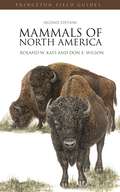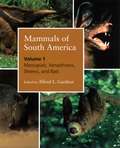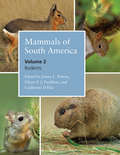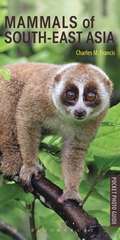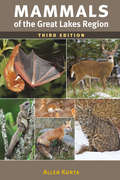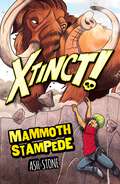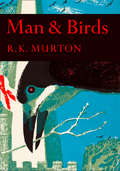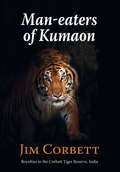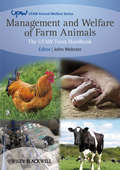- Table View
- List View
Mammals of North Africa and the Middle East (Pocket Photo Guides)
by Chris Stuart Tilde StuartThis handy guide provides an introduction to more than 120 species of mammals found in North Africa and the Middle East. The authoritative text includes key facts about identification, habitat, behaviour, distribution and status, and each species is illustrated with colour photographs, including many never previously published.Illustrated with clear colour photography and brief but authoritative descriptions the Pocket Photo Guides highlight the species of birds and animals from each region that the traveller is most likely to see, as well as those that are genuinely endemic (only to be seen in that country or region) or special rarities. The genuine pocket size allow the books to be carried around on trips and excursions and will take up minimal rucksack and suitcase space.
Mammals of North America: Second Edition
by Roland W. Kays Don E. WilsonThe best-selling field guide that "sets new standards" (New Scientist) and "makes all other field guides for mammals of the United States. . . and Canada obsolete" (Journal of Mammalogy) is now even better. Covering 20 species recognized since 2002 and including 13 new color plates, this fully revised edition of Mammals of North America illustrates all 462 known mammal species in the United States and Canada--each in beautiful color and accurate detail. With a more up-to-date species list than any other guide, improved facing-page descriptions, easier-to-read distribution maps, updated common and scientific names, and track and scat illustrations, this slim, light, and easy-to-use volume is the must-have source for identifying North American mammals. Roland Kays and Don Wilson have scoured the technical literature to pull out the key differences between similar species, and illustrated these whenever possible, making the guide useful to amateur naturalists and professional zoologists alike. Casual animal watchers will appreciate the overview of mammal diversity and the tips on identifying animals they can spy in their binoculars, while scientists will appreciate the exacting detail needed to distinguish similar species, including illustrations of shrew teeth, bat toes, and whale dorsal fins. The best-illustrated and easiest-to-use field guide to North American mammals Beautiful and accurate color illustrations of all 462 mammals found in the United States and Canada--including 20 species recognized since 2002 112 color plates--including 13 new ones Key identification information--fully revised--on facing pages The most current taxonomy/species list Fully revised, easy-to-read range maps Illustrations of tracks, scat, and whale and dolphin dive sequences
Mammals of North America: Second Edition
by Roland W. Kays Don E. WilsonThe best-selling field guide that "sets new standards" (New Scientist) and "makes all other field guides for mammals of the United States. . . and Canada obsolete" (Journal of Mammalogy) is now even better. Covering 20 species recognized since 2002 and including 13 new color plates, this fully revised edition of Mammals of North America illustrates all 462 known mammal species in the United States and Canada--each in beautiful color and accurate detail. With a more up-to-date species list than any other guide, improved facing-page descriptions, easier-to-read distribution maps, updated common and scientific names, and track and scat illustrations, this slim, light, and easy-to-use volume is the must-have source for identifying North American mammals. Roland Kays and Don Wilson have scoured the technical literature to pull out the key differences between similar species, and illustrated these whenever possible, making the guide useful to amateur naturalists and professional zoologists alike. Casual animal watchers will appreciate the overview of mammal diversity and the tips on identifying animals they can spy in their binoculars, while scientists will appreciate the exacting detail needed to distinguish similar species, including illustrations of shrew teeth, bat toes, and whale dorsal fins. The best-illustrated and easiest-to-use field guide to North American mammals Beautiful and accurate color illustrations of all 462 mammals found in the United States and Canada--including 20 species recognized since 2002 112 color plates--including 13 new ones Key identification information--fully revised--on facing pages The most current taxonomy/species list Fully revised, easy-to-read range maps Illustrations of tracks, scat, and whale and dolphin dive sequences
Mammals of South America, Volume 1: Marsupials, Xenarthrans, Shrews, and Bats
by Alfred GardnerThe vast terrain between Panama and Tierra del Fuego contains some of the world’s richest mammalian fauna, but until now it has lacked a comprehensive systematic reference to the identification, distribution, and taxonomy of its mammals. The first such book of its kind and the inaugural volume in a three-part series, Mammals of South America both summarizes existing information and encourages further research of the mammals indigenous to the region. Containing identification keys and brief descriptions of each order, family, and genus, the first volume of Mammals of South America covers marsupials, shrews, armadillos, sloths, anteaters, and bats. Species accounts include taxonomic descriptions, synonymies, keys to identification, distributions with maps and a gazetteer of marginal localities, lists of recognized subspecies, brief summaries of natural history information, and discussions of issues related to taxonomic interpretations.Highly anticipated and much needed, this book will be a landmark contribution to mammalogy, zoology, tropical biology, and conservation biology.
Mammals of South America, Volume 1: Marsupials, Xenarthrans, Shrews, and Bats
by Alfred L. GardnerThe vast terrain between Panama and Tierra del Fuego contains some of the world’s richest mammalian fauna, but until now it has lacked a comprehensive systematic reference to the identification, distribution, and taxonomy of its mammals. The first such book of its kind and the inaugural volume in a three-part series, Mammals of South America both summarizes existing information and encourages further research of the mammals indigenous to the region. Containing identification keys and brief descriptions of each order, family, and genus, the first volume of Mammals of South America covers marsupials, shrews, armadillos, sloths, anteaters, and bats. Species accounts include taxonomic descriptions, synonymies, keys to identification, distributions with maps and a gazetteer of marginal localities, lists of recognized subspecies, brief summaries of natural history information, and discussions of issues related to taxonomic interpretations.Highly anticipated and much needed, this book will be a landmark contribution to mammalogy, zoology, tropical biology, and conservation biology.
Mammals of South America, Volume 2: Rodents
by James L. Patton Ulyses F. J. Pardiñas Guillermo D'ElíaThe second installment in a planned three-volume series, this book provides the first substantive review of South American rodents published in over fifty years. Increases in the reach of field research and the variety of field survey methods, the introduction of bioinformatics, and the explosion of molecular-based genetic methodologies have all contributed to the revision of many phylogenetic relationships and to a doubling of the recognized diversity of South American rodents. The largest and most diverse mammalian order on Earth—and an increasingly threatened one—Rodentia is also of great ecological importance, and Rodents is both a timely and exhaustive reference on these ubiquitous creatures. From spiny mice and guinea pigs to the oversized capybara, this book covers all native rodents of South America, the continental islands of Trinidad and Tobago, and the Caribbean Netherlands off the Venezuelan coast. It includes identification keys and descriptions of all genera and species; comments on distribution; maps of localities; discussions of subspecies; and summaries of natural, taxonomic, and nomenclatural history. Rodents also contains a detailed list of cited literature and a separate gazetteer based on confirmed identifications from museum vouchers and the published literature.
Mammals of South America, Volume 2: Rodents
by James L. Patton Ulyses F. J. Pardiñas Guillermo D'ElíaThe second installment in a planned three-volume series, this book provides the first substantive review of South American rodents published in over fifty years. Increases in the reach of field research and the variety of field survey methods, the introduction of bioinformatics, and the explosion of molecular-based genetic methodologies have all contributed to the revision of many phylogenetic relationships and to a doubling of the recognized diversity of South American rodents. The largest and most diverse mammalian order on Earth—and an increasingly threatened one—Rodentia is also of great ecological importance, and Rodents is both a timely and exhaustive reference on these ubiquitous creatures. From spiny mice and guinea pigs to the oversized capybara, this book covers all native rodents of South America, the continental islands of Trinidad and Tobago, and the Caribbean Netherlands off the Venezuelan coast. It includes identification keys and descriptions of all genera and species; comments on distribution; maps of localities; discussions of subspecies; and summaries of natural, taxonomic, and nomenclatural history. Rodents also contains a detailed list of cited literature and a separate gazetteer based on confirmed identifications from museum vouchers and the published literature.
Mammals of South-east Asia (Pocket Photo Guides)
by Charles FrancisThis compact, easy-to-use identification guide describes 192 species of mammals found in South-east Asia, covering each major genus. The book features thumbnail silhouettes, a regional distribution map, and up-to-date tips on the best wildlife localities.Illustrated with clear colour photography and brief but authoritative descriptions the Pocket Photo Guides highlight the species of animals from each region that the traveller is most likely to see, as well as those that are truly endemic (only to be seen in that country or region) or special rarities. The genuine pocket size allow the books to be carried around on trips and excursions and will take up minimal rucksack and suitcase space.
Mammals of South-east Asia (Pocket Photo Guides)
by Charles FrancisThis compact, easy-to-use identification guide describes 192 species of mammals found in South-east Asia, covering each major genus. The book features thumbnail silhouettes, a regional distribution map, and up-to-date tips on the best wildlife localities.Illustrated with clear colour photography and brief but authoritative descriptions the Pocket Photo Guides highlight the species of animals from each region that the traveller is most likely to see, as well as those that are truly endemic (only to be seen in that country or region) or special rarities. The genuine pocket size allow the books to be carried around on trips and excursions and will take up minimal rucksack and suitcase space.
Mammals of Sri Lanka (Pocket Photo Guides)
by Gehan De WijeyeratneA compact, easy-to-use mammal identification guide for any nature watcher on a visit to Sri Lanka. More than 40 species are described here in detail, from the Grey Slender Loris to the Giant Squirrel and the Fishing Cat. All of these animals are clearly illustrated in a collection of specially commissioned colour photographs. With more than 130 full-colour photographs, a regional distribution map and handy tips on the best localities for spotting animals.Illustrated with clear colour photography and brief but authoritative descriptions the Pocket Photo Guides highlight the species of animals from each region that the traveller is most likely to see, as well as those that are truly endemic (only to be seen in that country or region) or special rarities. The genuine pocket size allow the books to be carried around on trips and excursions and will take up minimal rucksack and suitcase space.
Mammals of Sri Lanka (Pocket Photo Guides)
by Gehan de WijeyeratneA compact, easy-to-use mammal identification guide for any nature watcher on a visit to Sri Lanka. More than 40 species are described here in detail, from the Grey Slender Loris to the Giant Squirrel and the Fishing Cat. All of these animals are clearly illustrated in a collection of specially commissioned colour photographs. With more than 130 full-colour photographs, a regional distribution map and handy tips on the best localities for spotting animals.Illustrated with clear colour photography and brief but authoritative descriptions the Pocket Photo Guides highlight the species of animals from each region that the traveller is most likely to see, as well as those that are truly endemic (only to be seen in that country or region) or special rarities. The genuine pocket size allow the books to be carried around on trips and excursions and will take up minimal rucksack and suitcase space.
Mammals of the Great Lakes Region, 3rd Ed. (Great Lakes Environment)
by Allen KurtaNow in an extensively revised 3rd edition, Mammals of the Great Lakes Region has been an essential reference for countless amateur and professional naturalists since 1957. Easily tucked into a backpack and carried into the field, this heavily illustrated guidebook offers detailed information on 83 species, including each mammal’s appearance, behavior, and natural history, along with an explanation of its scientific name. Species accounts are accompanied by new color photographs plus fully updated distribution maps showing the geographic range in the Great Lakes region and in North America. A thorough introduction outlines the environmental factors that affect the distribution and abundance of mammals in Great Lakes ecosystems and discusses the impacts of current human activities, including introduction of diseases and climate change. There is also a section on preparing captured specimens for research or teaching, as well as user-friendly keys and quick reference tables to physical measurements and life history data. Brand new in this edition, the book also features detailed illustrations of the tracks of commonly found mammals to assist with year-round identification. Providing the most up-to-date information on mammals in the Great Lakes basin, this book belongs on the shelves of teachers, students, naturalists, and professional biologists throughout the region.
Mammals: A Very Short Introduction (Very Short Introductions)
by T. S. KempFrom a modest beginning in the form of a little shrew-like, nocturnal, insect eating ancestor that lived 200 million years ago, mammals evolved into the huge variety of different kinds of animals we see today. Many species are still small, and follow the lifestyle of the ancestor, but others have adapted to become large grazers and browsers, like the antelopes, cattle, rhinos, and elephants, or the lions, hyaenas, and wolves that prey upon them. Yet others evolved to be specialist termite eaters able to dig into the hardest mounds, or tunnel creating burrowers, and a few took to the skies as gliders and the bats. Many live partly in the water, such as otters, beavers, and hippos, while whales and dugongs remain permanently in the seas, incapable of ever emerging onto land. In this Very Short Introduction T. S. Kemp explains how it is a tenfold increase in metabolic rate - endothermy or "warm-bloodedness" - that lies behind the high levels of activity, and the relatively huge brain associated with complex, adaptable behaviour that epitomizes mammals. He describes the remarkable fossil record, revealing how and when the mammals gained their characteristics, and the tortuous course of their subsequent evolution, during which many bizarre forms such as sabre-toothed cats, and 30-tonne, 6-m high browsers arose and disappeared. Describing the wonderful adaptations that mammals evolved to suit their varied modes of life, he also looks at those of the mainly arboreal primates that culminated ultimately in Homo sapiens. ABOUT THE SERIES: The Very Short Introductions series from Oxford University Press contains hundreds of titles in almost every subject area. These pocket-sized books are the perfect way to get ahead in a new subject quickly. Our expert authors combine facts, analysis, perspective, new ideas, and enthusiasm to make interesting and challenging topics highly readable.
Mammals: A Very Short Introduction (Very Short Introductions)
by T. S. KempFrom a modest beginning in the form of a little shrew-like, nocturnal, insect eating ancestor that lived 200 million years ago, mammals evolved into the huge variety of different kinds of animals we see today. Many species are still small, and follow the lifestyle of the ancestor, but others have adapted to become large grazers and browsers, like the antelopes, cattle, rhinos, and elephants, or the lions, hyaenas, and wolves that prey upon them. Yet others evolved to be specialist termite eaters able to dig into the hardest mounds, or tunnel creating burrowers, and a few took to the skies as gliders and the bats. Many live partly in the water, such as otters, beavers, and hippos, while whales and dugongs remain permanently in the seas, incapable of ever emerging onto land. In this Very Short Introduction T. S. Kemp explains how it is a tenfold increase in metabolic rate - endothermy or "warm-bloodedness" - that lies behind the high levels of activity, and the relatively huge brain associated with complex, adaptable behaviour that epitomizes mammals. He describes the remarkable fossil record, revealing how and when the mammals gained their characteristics, and the tortuous course of their subsequent evolution, during which many bizarre forms such as sabre-toothed cats, and 30-tonne, 6-m high browsers arose and disappeared. Describing the wonderful adaptations that mammals evolved to suit their varied modes of life, he also looks at those of the mainly arboreal primates that culminated ultimately in Homo sapiens. ABOUT THE SERIES: The Very Short Introductions series from Oxford University Press contains hundreds of titles in almost every subject area. These pocket-sized books are the perfect way to get ahead in a new subject quickly. Our expert authors combine facts, analysis, perspective, new ideas, and enthusiasm to make interesting and challenging topics highly readable.
Mammoth Book of Shark Attacks, The (Mammoth Books)
by Alex MacCormickThe biggest-ever selection of first-hand accounts and news reports of shark attacks, both recent and historical, shows how sharks are masters of the ocean and how we enter their domain at our own risk. Think you're safe in the Med? Read about the Great Whites that thrive near holiday beaches. Think you're safe in large groups? Read about the sinking of the USS Indianapolis in 1945 when hundreds of sailors floated for days in shark-infested waters, being picked off one-by-one. Think you're safe at home? Read about the 69-year-old man, taking his regular evening swim, jumping off his backyard dock straight into the mouth of a bull shark. Many more extraordinary and gruesome accounts, including the shark-boat skipper who slit open the belly of a 360-kg tiger shark only to have a human head, pelvis, and arm come tumbling out, provide horrific and moving tales of shark encounters. The courage of survivors and those who have risked their lives to save shark attack victims is truly inspirational. Where can you find sharks? Features on different shark species with illustrations, fact boxes and maps show where they lurk around the world. Also included are a selection of full-colour photographs and special sections on the life cycle of a shark, how to avoid a shark attack and how to survive one.
Mammoth Stampede: Book 4 (Xtinct! #4)
by Ash StoneA giant woolly mammoth comes back to life in this action-packed adventure story.Time is running out! Barron Fox's hunting lodge is opening soon, and Jeevan discovers that he's planning a very big surprise for his guests - a woolly mammoth, brought back to life for them to hunt!If the lodge opens, the animals in the forest will be in danger too. Can Jeevan and his friends launch a daring rescue mission that tramples over Fox's plans?Perfect for fans of Beast Quest, Deadly 60 and Jurassic Park, these action-packed adventures will inspire readers to help save endangered species and combat extinction.
Man and Birds (Collins New Naturalist Library #51)
by R. K. MurtonHere is a fascinating and authoritative survey of the complex inter-relationships of bird and human life in this country.
Man and Wildfowl (Poyser Monographs #88)
by Janet KearThe involvement of humans with ducks, geese and swans has probably been closer than with any other group of birds, today and for several millenia past. This involvement, in its many aspects, is the theme of this compelling and readable account by an Assistant Director of the Wildfowl and Wetlands Trust. Dr Kear ranges widely, from a summary of the taxonomy and natural history of wildfowl, through a history of domestication world wide, to wildfowling, decoys, conservation and captive breeding, conflicts with agriculture, and wildfowl in legend and literature. Throughout, the text abounds with little-known facts and insights to intrigue the general reader and expert alike - a reflection of the author's wide reading and affection for her subject. Jacket illustrations by Joe Blossom
Man and Wildfowl (Poyser Monographs #88)
by Janet KearThe involvement of humans with ducks, geese and swans has probably been closer than with any other group of birds, today and for several millenia past. This involvement, in its many aspects, is the theme of this compelling and readable account by an Assistant Director of the Wildfowl and Wetlands Trust. Dr Kear ranges widely, from a summary of the taxonomy and natural history of wildfowl, through a history of domestication world wide, to wildfowling, decoys, conservation and captive breeding, conflicts with agriculture, and wildfowl in legend and literature. Throughout, the text abounds with little-known facts and insights to intrigue the general reader and expert alike - a reflection of the author's wide reading and affection for her subject. Jacket illustrations by Joe Blossom
Man-eaters of Kumaon (Oxford India Paperbacks Ser.)
by Jim CorbettThis is the Merlin Unwin Books edition and is the only one currently available which contains the iconic Raymond Sheppard illustrations which capture with remarkable verve and accuracy the dramatic highlight of each story. All royalties from the sale of the Merlin Unwin Books hardback edition go to the Corbett tiger reserve in India.The presence of a man-eating tiger in the Indian province of Naini Tal spread fear and panic throughout the impoverished rural community. This tigress had already killed 434 villagers by the time Jim Corbett was approached to track and despatch her in 1907.These thrilling and moving tales are Corbett’s first-hand accounts as, over the ensuing 29 years and at the request of desperate locals, he expertly tracks and kills various specific tigers and leopards which had become man-eaters, driven to this by injury or extreme old age.No one understood the ways of the Indian jungle better than Corbett. A skilled tracker, he preferred to hunt alone and on foot, sometimes accompanied by his small dog Robin. Corbett derived intense happiness from observing wildlife and he was a fervent conservationist as well as a tracker and ace shot.He empathised with the impoverished people amongst whom he lived, in what is today Uttarakhand, and he established India’s first tiger sanctuary there.Corbett’s writing is as immediate and accessible today as it was when first published in 1944.
Man Meets Dog
by Konrad LorenzIn this wonderful book, the famous scientist and best-selling author, Konrad Lorenz, 'the man who talked with animals', enlightens and entertains us with his illustrated account of the unique relationship between humans and their pets. Displaying Lorenz's customary humanity and expert knowledge of animals, Man Meets Dog is also a deeply personal and entertaining account of his relationships with his own four-legged friends. With charming sketches on almost every page, Man Meets Dog offers a delightful insight into animal and human thinking and feeling. An essential companion for all lovers of dogs (and cats!).
Man Meets Dog
by Konrad LorenzIn this wonderful book, the famous scientist and best-selling author, Konrad Lorenz, 'the man who talked with animals', enlightens and entertains us with his illustrated account of the unique relationship between humans and their pets. Displaying Lorenz's customary humanity and expert knowledge of animals, Man Meets Dog is also a deeply personal and entertaining account of his relationships with his own four-legged friends. With charming sketches on almost every page, Man Meets Dog offers a delightful insight into animal and human thinking and feeling. An essential companion for all lovers of dogs (and cats!).
The Man Who Loved Siberia
by Roy Jacobsen Anneliese PitzSiberia, to me, is a fairy-tale land.Fritz Dörries set out on his first trip to Eastern Siberia in 1877, when there were still blank spaces on maps of the world. Travelling alone or with his brothers, he climbed mountains, traversed great rivers, explored remote islands and crossed treacherous lakes of ice, always with one purpose: to augment man's knowledge of the natural world. Bears, tigers, vipers, bandits, stormy seas, frostbite, ice chasms fathoms deep - every danger was faced head on and overcome. And yet he remained defenceless against the charms of the landscape, and the animals, birds and butterflies he found there.Through his twenty-two years in Siberia, Dörries collected a wealth of essential material for scientific institutions, fundamental to our understanding of fauna and flora. This account of his adventures, set down for his daughters in his ninetieth year, and adapted for publication by Roy Jacobsen and Anneliese Pitz, is his second great legacy.Translated from the Norwegian by Seán Kinsella
The Man Who Vanished and the Dog Who Waited: A heartwarming mystery
by Kate Highfont size="+1">'Animal lovers will delight' Ann Granger'A real treat . . . I loved it. Cats, dogs, murder and a credible and relatable heroine' Barbara NadelSummer in the Lincolnshire Wolds and Clarice is rung by her friend Louise, asking whether she can look after Susie, her son's lively Boxer, as 41-year-old Guy has gone missing from the family home. His mother thinks he has been suffering from depression but more worryingly, in his professional life, he had been working on a high-profile case, defending a known criminal. His home life was beset with problems too, which is why his mother has asked Clarice to look after the dog; Charlotte, Guy's wife, just can't cope with her as well as their three daughters.Getting drawn into the puzzle of Guy's disappearance, Clarice wonders how Susie received a nasty cut to her back leg, and who is the mysterious Charles? Guy apparently did not trust him enough to let him into his home, and he had not been seen since he was driven away in Charles car. Guy's friends all say that he was a good, honest man, but as Clarice looks further into the murky criminal world he inhabits, she questions if Guy has been pulled in out of his depth. And - why does Susie keep returning to the private woods, where she had spent so much time with her beloved master....
Management and Welfare of Farm Animals: The UFAW Farm Handbook (UFAW Animal Welfare #9)
by John WebsterThrough successive editions, Management and Welfare of Farm Animals has gained international recognition as a classic introductory textbook for students of agriculture and veterinary science. Conceived by the Universities Federation for Animal Welfare (UFAW), the book has always sought to promote the humane treatment of livestock within the practical business context of modern farming. Now fully revised and updated, this fifth edition remains the most comprehensive and accessible guide available. Three animal groups appear here for the first time (game birds, South American camelids, and ostriches), and a chapter on horses has also been restored. Throughout, the book offers clear advice for the humane management of all major farmed species in the primary context of large-scale food production. However, this edition also takes full account of consumer demand (and legal requirements) for alternative farming methods and enhanced welfare standards, whether in conventional agriculture or the smallest of ‘hobby' farms. Brand new chapters reflect fresh understanding of welfare science, ethics, and the role of society in ensuring the best possible farm conditions. It remains an indispensable resource for students, and for all those seeking to promote animal welfare. Published as a part of the prestigious Wiley-Blackwell – UFAW Animal Welfare series. UFAW, founded 1926, is an internationally recognised, independent, scientific and educational animal welfare charity. For full details of all titles available in the UFAW series, please visit www.wiley.com/go/ufaw.

